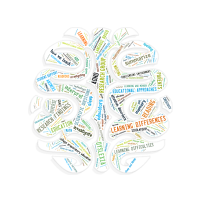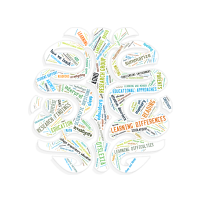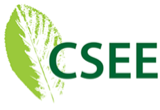

Lab Faculty and Staff
12/3/2018
How are Individual Differences Related to Response to Challenges?
When do rewards promote motivation in the classroom -- and when do they get in the way?
How does failure impact student motivation, and how can we help students with learning differences to persevere through challenges?
What do we know about the brain pathways that support motivation?
How does project based learning foster student motivation?
These are some of the questions that The Lab School of Washington's Scientific Review Group investigated this past year. Our next summary continues our exploration of the different ways students cope with failure, and how this impacts motivation.
A variety of factors impact how individuals react to challenging activities or experiences of failure. The following factors discussed below affect responses to failures: an individual’s diagnosis, his or her self-concept, his or her orientation towards avoiding threats versus seeking success, and gender (male or female).
-
Differences based on diagnosis
- Autism
- Learning Disabilities
- Attention Deficit Hyperactivity Disorder
Autism
Perhaps one of the most important factors to consider is an individual’s diagnosis. Studies of motivation in children with autism reveal that “motivation may be depressed, performance impaired and task avoidance increased by repeated experiences of failure” (1). Children with autism who completed tasks incorrectly have been found to exhibit “extremely low” motivation (2).
Learning Disabilities
In one research study, typical boys and boys with learning disabilities (LD) were presented with problem-solving tasks. While students with learning disabilities (LD) and typical students both took longer to resolve a problem-solving task than students who had been trained in using metacognitive strategies, the untrained non-LD students showed greater independent strategy-use and persistence in working towards a solution than did their LD peers (3). The LD students quickly gave up on additional tasks presented, did not wish to continue problem-solving at home, and tended to attribute their failures to the difficulty level of the task. These results suggest that students with LD have deficits in metacognition (i.e., awareness and understanding of their own thought processes) (4). It is also important to remember that students who have received a diagnosis of LD have likely had a history of failures or greater challenges than typically-developing students. Though metacognitive impairments could certainly be at play, it is also possible that these students experienced the effects of compounded failures over time, which drove them to limit the damage to their self-concept by reducing attempts on any challenging tasks.
Supporting this idea, existing research indicates that students with learning disabilities, including dyslexia, have more negative self-concepts than students with typical achievement in school (5). They are more likely to attribute failure to a lack of innate skills than students with stronger self-concepts and are more likely to explain failure by attributing it to their own lack of ability (5). A reciprocal relationship (i.e., both sides affect each other) between attributions of academic success or failure and motivation. Attributions are affected by motivation but continued motivation on subsequent tasks is also impacted by how students perceive their successes or failures.
Attention Deficit Hyperactivity Disorder:
Students with attention deficits or executive function challenges (e.g., ADHD) may have similar challenges coping with failure. Individual differences in the function of dopamine, which plays a crucial role in effort-based decision-making, is also associated with a willingness to exert high effort (6). The dopaminergic system is altered in ADHD individuals. (For a more in depth discussion of the interaction of ADHD and motivation, please see previous summaries on this topic.
Click on the following links for citations of research articles used to write this section:
- Koegel & Mentis, 1985, p. 185
- Koegel and Egel, 1979
- Schunk, 1982
- Cullen, 1982, 1985
- Cooley & Ayres, 1988
- Anand et al., 2016
-
Sex differences
Sex differences may also impact how students deal with failure. A study on sex differences among fifth graders revealed that high-achieving girls showed preferences for activities at which they felt they excelled, whereas high-achieving boys preferred tasks that would likely require greater effort to master (1). No significant sex differences were found between subjects who tended to achieve grades of Bs, Cs or Ds, but there was a significant effect based on gender for higher achieving students. Girls who made As showed the poorest response to failure, while boys who made As actually experienced facilitation from failure. Similarly, a study of high-achieving junior high school students showed that girls had a greater tendency than boys towards thinking of intelligence as a fixed, immovable trait (2). Girls who thought this way also opted for goals that provided less of a challenge. These sex differences are especially noticeable among bright students, indicating that adaptive motivational responses do not necessarily go hand-in-hand with achievement.
Click on the following links for citations of research articles used to write this section:
- Licht et al., 1984
- Leggett, 1985
-
Cognitive differences in success-orientation
Differences in approach to difficulty also depend upon an individual’s motivational profile. The “quadripolar model” categorizes individuals into one of four groups based on their success orientation and fear of failure (1). In this model, students can be classified as optimists (high success oriented with low fear of failure), overstrivers (high fear of failure and high success orientation), self-protectors (high fear of failure with low success orientation) or failure acceptors (low in both fear of failure and success orientation).
Optimists demonstrate resiliency in the face of failure and do not engage in cognitive responses like self-handicapping or defensive pessimism to protect themselves. Overstrivers, on the other hand, are actually motivated by failure to exert increased effort (often resulting in success), though this constant exertion can then generate higher anxiety, fatigue, and low resiliency following set-backs. Self-protectors tend to try to minimize failures and point to external factors that contributed to their failings (hence protecting their own self-concept). They may engage in self-handicapping behaviors, such as avoiding tasks, choosing to expend little effort, procrastinating, claiming illness or physical ailments, which in turn predict lower achievement over time. Failure acceptors tend to exhibit low self-esteem, like overstrivers and self-protectors, but they respond to difficulty with indifference and disengagement, leading to the poorest academic achievement. Can you think of students you work with who might fall into one of these categories?
The study that outlined these categories investigated the relationship between success orientation versus fear of failure and behavioral outcomes (like self-handicapping) in two populations; their results demonstrated that using these categories helped to predict students’ responses in both Eastern and Western cultures (1). Other studies found that upper-elementary “risk avoiders” felt more negatively about a task after failure than their peers did, and those who experienced negative affect following failure were more likely to try to escape, negotiate out of, or devalue their work (2).
Click on the following links for citations of research articles used to write this section:
-
Growth mindset
“Growth mindset” is an approach to learning that emphasizes exerting effort as a route to success, rather than possessing innate intelligence or skill. Growth mindset stands in contrast to “fixed mindset,” that is, thinking of intelligence as a limited, unchangeable trait, and considering one’s success to be dependent on how much intelligence or talent one possesses. Carol Dweck’s research reveals how different approaches to learning can shape a student’s interpretation of and response to challenges and failure (1). Children’s attributions of success and failure can predict their responses to failure (2). Specifically, if a student explains his success by pointing out his effort, he will tend to persist on a task even when confronted with failure.
Growth mindset research also looks at achievement motivation, including motivation towards either learning goals (i.e., goals focused on increasing competence) or performance goals (i.e., goals focused on trying to avoid negative judgment or garner favorable judgments regarding one’s competence) (3). Some individuals exhibit “mastery oriented” or adaptive behavior, showing persistence and grit in the face of challenges, whereas other individuals demonstrate maladaptive responses like anxiety, poor persistence, avoidance of challenging situations, and negative self-talk. Children who have adaptive motivational patterns exhibit improvements in performance when the level of difficulty or challenge increases or even seek out challenge to enhance learning. Students who show greatest persistence in the face of obstacles and set-backs tend to “think of their mistakes as problems to be solved” rather than ruminating about their failure (1). Attributing failure to a lack of ability decreases motivation, whereas thinking of errors as temporary problems to be resolved with increased or redirected effort leads to increased persistence on subsequent tasks (1).
The specific type of goal presented when approaching a task can change how students interpret their performance. While those who are given performance goals tend to think of errors or failures as indicative of poor ability, children presented with learning goals consider challenges as a cue to change tactics or increase effort. Whereas students’ confidence in their skills must be high in order for them to select challenging tasks in the context of a performance goal, framing a task with a learning goal allows students to approach challenge as an opportunity for growth, even when their self-confidence in their abilities is low (1). Similarly, students in a state of “flow” typically report experiencing a clear sense of direction or purpose, high concentration, a good match between the level of challenge and the level of their skills, and time passing quickly for them. Flow Theory suggests that optimal learning results from intrinsic motivation and a positive emotional state, when mastery goals and teacher support are also present (4).
Click on the following links for citations of research articles used to write this section:
- Dweck, 1986
- Deiner & Dweck, 1978
- Dweck & Elliott, 1983; Nicholls, 1984; Nicholls, 1979
- Meyer & Turner, 2005
In summary, it is important to remember that we all fail and we all succeed at times. We fail to meet expectations; we fall short of goals set by ourselves and others. The more we expect from ourselves, the more likely we are to experience some degree of failure. We also succeed, sometimes with little victories, like clearing an email inbox, and sometimes in bigger ways, like watching a student finally read a chapter book. We hope these summaries have inspired you to reconsider how you approach success and failure, as well as how to help your students reframe failure in a positive light. Given support and autonomy, our students can view each mistake they make as a learning moment and use failures as handholds to climb towards future successes.
Citations
Anand, D., Oehlberg, K. A., Treadway, M. T., & Nusslock, R. (2015). Effect of failure/success feedback and the moderating influence of personality on reward motivation. Cognition and Emotion,30(3), 458-471. doi:10.1080/02699931.2015.1013088
Atkinson, J.W. (1964). An introduction to motivation. Princeton, NJ: Van Nostrand.
Bandura, A. (1986). The Explanatory and Predictive Scope of Self-Efficacy Theory. Journal of Social and Clinical Psychology: Vol. 4, Special Issue: Self-Efficacy Theory in Contemporary Psychology, pp. 359-373. https://doi.org/10.1521/jscp.1986.4.3.359
Bandura, A. (1991). Social cognitive theory of self-regulation. Organizational behavior and human decision processes, 50(2), 248-287.
Brunstein, J. C., & Gollwitzer, P. M. (1996). Effects of failure on subsequent performance: The importance of self-defining goals. Journal of Personality and Social Psychology,70(2), 395-407. doi:10.1037//0022-3514.70.2.395
Castella, K. D., Byrne, D., & Covington, M. (2013). Unmotivated or motivated to fail? A cross-cultural study of achievement motivation, fear of failure, and student disengagement. Journal of Educational Psychology,105(3), 861-880. doi:10.1037/a0032464
Clifford, M. M. (1988). Failure tolerance and academic risk-taking in ten- to twelve-year-old students. British Journal of Educational Psychology, 58, 15–27.
Clifford, M. M. (1991). Risk taking: Theoretical, empirical, and educational considerations. Educational Psychologist, 26, 263–298.
Cooley, E. J., & Ayres, R. R. (1988). Self-Concept and Success-Failure Attributions of Nonhandicapped Students and Students with Learning Disabilities. Journal of Learning Disabilities,21(3), 174-178. doi:10.1177/002221948802100310
Cullen, J. L., & Boersma, F. J. (1982). The influence of coping strategies on the manifestation of learned helplessness. Contemporary Educational Psychology,7(4), 346-356. doi:10.1016/0361-476x(82)90019-4
Cullen, J.L. (1985). Children's ability to cope with failure: Implications of a metacognitive approach for the classroom. In D.L. Forrest-Pressley , G.E. Mackinnon , & T.G. Waller (Eds), Metacognition, cognition, and human performance, Vol. 2. New York: Wiley , pp. 267-300.
Diener, C. I., & Dweck, C. S. (1978). An analysis of learned helplessness: Continuous changes in performance, strategy, and achievement cognitions following failure. Journal of Personality and Social Psychology,36(5), 451-462. doi:10.1037//0022-3514.36.5.451
Dweck, C. S. (1986). Motivational processes affecting learning. American Psychologist,41(10), 1040-1048. doi:10.1037//0003-066x.41.10.1040
Dweck, C. S. (2015). The Secret to Raising Smart Kids. Scientific American Mind,18(6), 36-43. doi:10.1038/scientificamericanmind1207-36
Dweck, C. S., & Elliott, E. S. (1983). Achievement motivation. In P. H. Mussen (Gen. Ed.) & E. M. Hetherington (Vol. Ed.), Handbook of chiM psychology: 1Iol. IV. Social and personality development (pp. 643-691). New York: Wiley.
Ford, C. E., & Brehm, J. W. (1987). Effort Expenditure Following Failure. Coping with Negative Life Events, 81-103. doi:10.1007/978-1-4757-9865-4_4
Koegel, R. L., & Egel, A. L. (1979). Motivating autistic children. Journal of Abnormal Psychology,88(4), 418-426. doi:10.1037//0021-843x.88.4.418
Koegel, R. L., & Mentis, M. (1985). Motivation In Childhood Autism: Can They Or Won't They? Journal of Child Psychology and Psychiatry,26(2), 185-191. doi:10.1111/j.1469-7610.1985.tb02259.x
Licht, B. G., & Dweck, C. S. (1984). Determinants of academic achievement: The interaction of children's achievement orientations with skill area. Developmental Psychology,20(4), 628-636. doi:10.1037//0012-1649.20.4.628
Legget, E. (1985, March). Children's entity and incremental theories of intelligence: Relationships to achievement behavior. Paper presented at the meeting of the Eastern Psychological Association, Boston.
Meyer, D. K., & Turner, J. C. (2006). Re-conceptualizing Emotion and Motivation to Learn in Classroom Contexts. Educational Psychology Review,18(4), 377-390. doi:10.1007/s10648-006-9032-1
Miller, W.R. & Seligman, M.E.P. (1975). Depression and learned helplessness in man. Journal of Experimental Psychology, 84, 228-238.
Nicholls, J. G. (1979). Development of perception of own attainment and causal attributions for success and failure in reading. Journal of Educational Psychology,71(1), 94-99. doi:10.1037//0022-0663.71.1.94
Nicholls, J. G. (1984). Achievement motivation: Conceptions of ability, subjective experience, task choice, and performance. Psychological Review,91(3), 328-346. doi:10.1037//0033-295x.91.3.328
Overmier, O.B., & Seligman, M.E.P. (1967). Effects of inescapable shock upon subsequent escape and avoidance learning. Journal of Comparative Physiological Psychology, 63, 28-33.
Schunk, D. H. (1982). Effects of effort attributional feedback on children's perceived self-efficacy and achievement. Journal of Educational Psychology,74(4), 548-556. doi:10.1037//0022-0663.74.4.548
Seligman, M.E.P & Maier, S.F. (1967). Failure to escape traumatic shock. Journal of Experimental Psychology, 74, 1-9.
Skinner, E. A., Pitzer, J. R., & Brule, H. A. (2014). The role of emotion in engagement, coping, and the development of motivational resilience. In R. Pekrun & Linnenbrink-Garcia, L. (Eds.), International Handbook of Emotions and Education (331-347). New York: Taylor & Francis.
Skinner, E.A. (in press). Engagement and disaffection as central to processes of motivational resilience development. In K. Wentzel & D. Miele (Eds.), Handbook of Motivation at School, 2nd ed. Malwah, NJ: Erlbaum.




